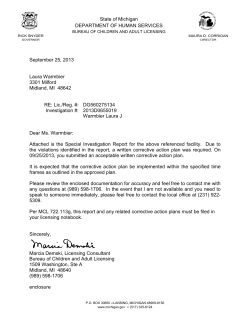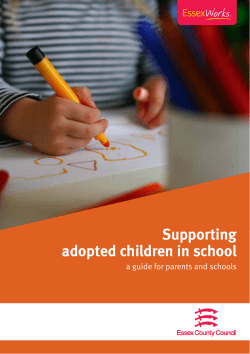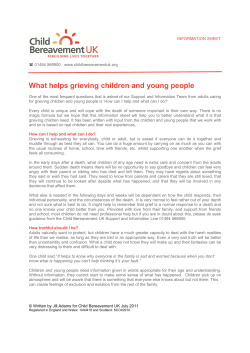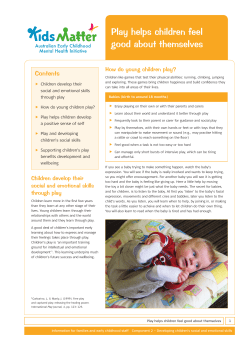
Using Children ’ s Literature Differently
Using Children’s Literature Differently…..Addressing Academic/ Behavioral/Personal/Emotional Issues of ALL Learners Laura Beltchenko Lbeltchenko@gmail.com Associate Superintendent Curriculum and Instruction, Wauconda CUSD #118 Doctoral Student, National Louis University, Illinois The OK Book Amy Rosenthal and illustrated by Tom Lichtenheld Laura Beltchenko, 2013 2 Bridging the Cognitive and Affective Domains in the Classroom Today’s Agenda • Create an adult learning environment • Demonstrate the use of children’s literature as “mentor texts” for academic and social behaviors development • Share standards and different models of Social/Emotional Learning • Walk away with activities that can be used in your classroom that weave reading, writing and personal/social/emotional development • A personal thank you for allowing me to share my passion for children’s literature. LB Laura Beltchenko, 2013 3 What Do We Know About Student Learning? • Brain research tells us: Laura Beltchenko, 2013 4 Laura Beltchenko, 2013 5 Affective or Social/Emotional Learning • As teachers, we naturally emphasize the cognitive domain in our teaching. After all, students think and learn with their brains (we hope!). Yet the affective domain can significantly enhance, inhibit or even prevent student learning. The affective domain includes factors such as student motivation, attitudes, perceptions and values. Teachers can increase their effectiveness by considering the affective domain in book selection, lesson planning, read alouds, center activities. Laura Beltchenko, 2013 6 Sequenced, Active, Focused and Explict Durlak, Taylor, Weissberg, Schellinger, 2011 • S: use a Sequenced set of activities to achieve skill objectives • A: use Active forms of learning • F: include at least one program component Focused on developing personal or social skills • E: Explicitly target particular personal or social skills for development Laura Beltchenko, 2013 7 Laura Beltchenko, 2013 8 What do We Need as Educators, to Support our Students Social and Emotional Needs? • Maturity: Maturity self-awareness, self-acceptance, tolerance of others. • Integrity: Integrity respect for self and others that enables the teacher to avoid exploitation of emotions. • Responsibility: Responsibility an attitude of responsiveness as well as a willingness to guide group participants through potentiall difficult discussions • Adaptability: Adaptability the ability to adjust plans to meet the needs of the group at the moment, and to allow participants their own interpretations. Laura Beltchenko, 2013 9 Attributes continued: • Empathy: Empathy the ability to understand another person’s feelings without actually experiencing them. • Respect: Respect the recognition of the value of another person’s feelings, and his or her inherent worth and uniqueness. • Genuineness: Genuineness sincerity, spontaneity, openness; awareness and acceptance of one’s own inner experiences. Laura Beltchenko, 2013 10 Laura Beltchenko, 2013 11 Illinois PBIS “+” Illinois Social and Emotional Learning Standards Laura Beltchenko, 2013 12 Emotional Intelligence Emotional Intelligence is the ability to perceive and express emotions, emotions to understand and use them and to manage emotions so as to foster personal growth. Salovey & Mayer, 1990, 1997, 2000 Laura Beltchenko, 2013 13 Picture Books and the Art that Tells Their Stories Although each attribute in the E.I. Framework is valuable, today’s presentation will focus on the Regulation of Emotions. • Be open to feelings both pleasant and unpleasant. • Monitor and reflect on emotions • Manage emotion in oneself or others through personal action Laura Beltchenko, 2013 14 The Nice Book David Ezra http://blaine.org/sevenimpossiblethings/?p=1478 Laura Beltchenko, 2013 15 (CASEL) http://casel.org/ “CASEL focuses on SEL as an essential part of education and speaks of five basic sets of skills or competencies that can be systematically focused on at home and in school.” CASEL, 2011 Their five core competencies, provide the behavioral support that provide students with a foundation for successful learning. Laura Beltchenko, 2013 16 Laura Beltchenko, 2013 17 CASEL Core Competencies: Achieving Success in School, Work and Life 1. SelfAwareness: Identify ones thoughts, feeling and strengths, and recognizing how they influence one’s choices and actions. Laura Beltchenko, 2013 18 The Big Orange Splot Daniel Pinkwater 2. Social-Awareness: Identify and understand the thoughts and feelings of others, respecting their rights and appreciating diversity. Laura Beltchenko, 2013 21 CASEL Core Competencies: Achieving Success in School, Work and Life • 3. Self-Management Establishing and working toward short and long term goals, and handling emotions so that they facilitate rather than interfere with the task at hand. Laura Beltchenko, 2013 23 CASEL Core Competencies: Achieving Success in School, Work and Life • 4. Responsible Decision Making: Generating implementing and evaluating positive and informed solutions to problems, and assuming responsibility for personal decisions and behaviors. Laura Beltchenko, 2013 25 Responsible Decision Making Award-Winning Children’s Author and Illustrator Kevin Henkes Laura Beltchenko, 2013 26 CASEL Core Competencies: Achieving Success in School, Work and Life 5. Relationship Skills: Learning the skills to communicate, listen and negotiate situations to establish and maintain healthy and rewarding connections with individuals and groups. Laura Beltchenko, 2013 27 Laura Beltchenko, 2013 28 Laura Beltchenko, 2013 29 Laura Beltchenko, 2013 30 Laura Beltchenko, 2013 31 Illinois Social/Emotional Learning Standards • Goal 1: 1 Develop self-awareness and self-management skills to achieve school and life success. Why this goal is important: important Involves knowing your emotions, how to manage them and ways to express them constructively. Laura Beltchenko, 2013 32 Learning Standard 1A: Identify and Manage One’s Emotions and Behavior • Early Elementary 1A.1a, Recognize and accurately label emotions and how they are linked to behavior. • Later Elementary 1A.2a, Describe a range of emotions and the situations that cause them. Laura Beltchenko, 2013 33 Learning Standard 1A: Identify and Manage One’s Emotions and Behaviors • Middle School 1A.3a, Analyze factors that create stress or motivate successful performance. • Early H.S 1A.4a, Analyze how thoughts and emotions affect decision making and responsible behavior. Laura Beltchenko, 2013 34 Learning Standard 1A: Identify and Manage One’s Emotions and Behavior • Early Elementary 1A.1b, Demonstrate control of impulsive behavior. • Late Elementary 1A.2b, Describe and demonstrate ways to express emotions in a socially acceptable manner. Laura Beltchenko, 2013 35 Learning Standard 1A: Identify and Manage One’s Emotions and Behavior • Middle School 1A.3b, Apply strategies to manage stress and to motivate successful performance. • Early H.S. 1A.4b, Generate ways to develop more positive attitudes. • Late H.S. 1A.5b, Evaluate how expressing more positive attitudes influences others. Laura Beltchenko, 2013 36 Illinois Social and Emotional Learning Standards • Goal 2: 2 Use social-awareness and interpersonal skills to establish and maintain positive relationships. Why this goal is important: important Success in school and life requires us to have the ability to recognize the thoughts, feelings and perspectives of others, including those different from ones own. Laura Beltchenko, 2013 37 Goal 2., Learning Standard A: Recognize the feelings and perspectives of others Verbs that are designed to build upon knowledge: • Early Elem: Recognize • Late Elem: Identify • Middle/Jr. High: Predict • Early H. S.: Analyze • Late H. S.: Demonstrate Laura Beltchenko, 2013 38 Learning Standard 2A: Recognize the feelings and perspectives of others. • Early Elementary 2A.1a, Recognize that others may experience situations differently from oneself. • Late Elementary 2A.2a, Identify verbal, physical and situational cues that indicate how others may feel. Laura Beltchenko, 2013 39 Learning Standard 2A: Recognize the feelings and perspectives of others. Middle/Jr. High 2A.3a Predict others’ feelings and perspective in a variety of situations. Early H. S., 2A.4a Analyze similarities and difference between one’s own and others’ perspectives. Laura Beltchenko, 2013 40 Learning Standard 2Ab: Recognize the feelings and perspectives of others. • Early Elementary 2A.1b, Use listening skills to identify the feelings and perspectives of others. • Late Elementary 2A.2b., Describe the expressed feeling and perspectives of others. Laura Beltchenko, 2013 41 Illinois Social and Emotional Learning Standards • Goal 3. 3 Demonstrate decision-making skills and responsible behaviors in personal, school and community contexts. Why this Goal is Important: Important Achieving these outcomes requires an ability to make decisions, solve problems, generate alternative solutions and learn from one’s decision making. Laura Beltchenko, 2013 42 Goal 3, Learning Standard A: Consider ethical factors in making decisions. • Early Elementary 3A.1a, Explain why unprovoked acts that hurt others are wrong. • Late Elementary 3A.1b, Demonstrate the ability to respect the rights of self and others. Laura Beltchenko, 2013 43 Goal 3, Learning Standard B:Apply decision making skills to deal responsibly with daily academic and social situations. • Early Elementary 3B.1a, Identify a range of decisions that students make at school. • Late Elementary 3B.1b, Identify and apply the steps of systematic decision making. Laura Beltchenko, 2013 44 Goal 3, Learning Standard B: Apply decision making skills to deal responsibly with daily academic and social situations. • Middle/J. High 3B.3a., Analyze how decision-making skills improve study habits and academic performance. • Early H.S. 3B.4a., Evaluate personal abilities to gather information, generate alternatives, and anticipate the consequences of decisions. Laura Beltchenko, 2013 45 Turn and…. Laura Beltchenko, 2013 46 Mellow Out…gives voice to emotional life… and to gifted children “Our culture is not always kind to individuals who behave a little differently. Thus, even when they are in association with negative behaviors or disorders, overexcitabilities may be seen as strange.” Michael M. Piechowski, Yunasa Books, Madison, Wisconsin 2006, www.mellowout.us Laura Beltchenko, 2013 47 Emotional Intelligence Framework from Vantassel-Baska, Cross & Olenchak, 2009 • Perception, appraisal, and expression of Emotion • Emotional facilitation of thinking • Understanding and analyzing emotional information • Regulation of emotion Laura Beltchenko, 2013 48 Asynchronistic Development http://www.hoagiesgifted.org/asynchrony_squared.htm As Linda Kreger Silverman so aptly describes it "...gifted children develop in an uneven manner, ... they are more complex and intense than their age-mates, ... they feel out-of-sync with age peers and 'age appropriate curriculum,' ... the internal and external discrepancies increase with IQ, and ... these differences make them extremely vulnerable." Laura Beltchenko, 2013 49 The Mysterious Benedict Society Trilogy Laura Beltchenko, 2013 50 Children's Literature Embraces these Attributes • 1. Psychomotor • 2. Sensual (senses) • 3. Imaginational • 4. Intellectual • 5. Emotional Laura Beltchenko, 2013 51 Dabrowski’s Theory of Emotional Development Examples of Heightened Sensitivities (overexcitabilities). (Piechowski, 2006) 1. Psychomotor • Organic excess of energy • Love of movement for its own sake • Rapid speech • Pursuit of Intense physical activity • Impulsiveness and restlessness • Intense drive Laura Beltchenko, 2013 52 Clarice Bean series by Lauren Child. Website: http://www.milkmonitor.com/ Joey Pigza series by Jack Gantos Jack Gantos's second book about Joey Pigza is just as delightful and soulful as his first. Joey's attempts to keep the fragile peace in his life intact are touching, and his intense longing to just be normal will mirror the feelings of most preteens, whether they have ADD or not. Joey Pigza may sometimes lose control, but he never loses his heart. Laura Beltchenko, 2013 53 Dabrowski’s Theory of Emotional Development Examples of Heightened Sensitivities (overexcitabilities). (Piechowski, 2006) 2. Sensual (5 senses) • Heightened experience of sensual pleasure Seeking sensual outlets for inner tension • Desires for comfort, luxury and refined beauty • Pleasures of taste and smell Laura Beltchenko, 2013 54 Sensual (5 senses) Laura Beltchenko, 2013 55 Dabrowski’s Theory of Emotional Development Examples of Heightened Sensitivities (overexcitabilities). (Piechowski, 2006) • • • • • • 3. Imaginational Dreams are retold in detail and vivid color Predilection for fairy tales and magic Love of poetic language, rich imagery, fantasy Speaking and writing in metaphors Imaginary companions Inventiveness Laura Beltchenko, 2013 56 Imaginational Laura Beltchenko, 2013 57 Dabrowski’s Theory of Emotional Development Examples of Heightened Sensitivities (overexcitabilities). (Piechowski, 2006) • • • • • 4. Intellectual Persistence in asking probing questions Sharp sense of observation Independence of thought Striving for synthesis of knowledge Striving for more understanding and truth than with academic learning and achievement Laura Beltchenko, 2013 58 Dabrowski’s Theory of Emotional Development Examples of Heightened Sensitivities (overexcitabilities). (Piechowski, 2006) • • • • • • • • 5. Emotional Compassion and empathy Strong affective recall of past experiences Intense desire to offer love Fears, anxieties, depression Enthusiasm and excitation Intense loneliness Attachment to persons, living things or places Great intensity of feelings. Laura Beltchenko, 2013 59 What Does SEL Look Like in My Classroom? The How and When of SEL. Start with a read aloud and a retelling ☺ Developmental Bibliotheraphy can provide a framework to lesson planning. Looking at a Read Aloud…. Differently How Do We Use Pictures Books to Lead in a Social/Emotional Book Discussion/Read Aloud: 1. Pre read the book. (that goes without staying) 2. Introduce why you are reading this selection to the child. (To focus on a characters feelings) 3. Maximize successful listening and talking skills. 4. Open and guide discussion using open ended questioning. 5. Balance “heavy” and “light” experiences in the book. Laura Beltchenko, 2013 61 Light and Heavy Laura Beltchenko, 2013 62 And the Important Attributes are….. • To know and enjoy children’s literature, understand child development in general as well as that of special needs, gifted and culturally diverse students. • You must also gain the trust of the children with whom you are working and know something about how to use children's books for both the cognitive and affective domains. Laura Beltchenko, 2013 63 Start with Authors that Address Children’s (Personal/Social) Issues Laura Beltchenko, 2013 64 Examples of Student Character Education Behavior Traits • Citizenship: Citizenship Working • Honesty: Honesty Rely on together, sense of yourself to tell the truth community and and keep your word. cooperation. • Courage: Courage Logical risk• Respect: Respect Treat others taking and truth the way you want to be • Social Justice: Justice treated. Heightened awareness, • Compassion: Compassion Show that acceptance and tolerance you care about others of individual differences by treating them with • Humor: Ability to laugh kindness and as ones self as well as understanding. demonstrate a positive • Responsibility: Responsibility You are attitude. accountable for the things you say and do. Laura Beltchenko, 2013 65 Character Counts/First Class • Trustworthiness/Honesty/Courage • Respect/Acceptance • Responsibility/Self control/Perseverance • Fairness/ Problem Solving • Caring/Compassion • Citizenship/Teamwork Laura Beltchenko, 2013 66 Authors and Illustrators of good children's literature use language and illustrations that delight and intrigue the reader. http://www.education.wisc.edu/ccbc/books/detailListBooks.asp?idBookLists=175 Author Peggy Rathmann Laura Beltchenko, 2013 67 Fulfilling Illustrations • Details of the illustrations should be so fascinating that a child can look repeatedly and always find more: a surprise or a bit of humor, a special feeling or relationship just by looking at the characters face, eyes or body posturing. Laura Beltchenko, 2013 68 These and other books depict Character Trait Development and Personal/Emotional Learning Laura Beltchenko, 2013 69 Character Feelings and Traits • A feeling is an emotion that changes, but a trait describes what the character is like on the inside. • A trait usually does not change in short story. • One effective way to teach character traits and increase vocabulary is to connect the trait to a familiar person in a current or historical event. Laura Beltchenko, 2013 70 Characters and Animals or Humans Books should depict characters whether animal or human who display real emotions, feelings and relationships that the student can recognize. Laura Beltchenko, 2013 71 Developmental Bibliotheraphy • Does not require a trained mental health professional. • It is meant to help prevent problems not to cure them. • Hynes and Hynes-Berry (1986) list some of the qualifications that teachers already possess. Laura Beltchenko, 2013 72 Stages of Bibliotheraphy Yes, you are doing this as you set up your picture book/literature or discussions/read alouds in your classrooms. Lets view them in terms of character traits. • Identification • Surfacing of Emotions • (the Catharsis) • Insight • Universalization Laura Beltchenko, 2013 73 Identification (recognizing) • The process by which the reader identified with a character in the book, recognizing something of himself in what is pointed out or read in the story. Book characters can be very real to children. • We often call this a ……. Text to self connection Laura Beltchenko, 2013 74 Surfacing of Feelings) (catharsis) • This occurs as the reader follows the character through a difficult situation to a successful resolution. This is a continuation of Text to Self and incorporating Text to World situations. Laura Beltchenko, 2013 75 Relationships of the Characters Using the story in a Readers Theatre or shared dialog to assist in the identification (recognition) of an issue brings it to catharsis (piquing awareness) and sees it through to insight and (thinking) about our self as it relates to the characters. Laura Beltchenko, 2013 76 Insight (thinking) • The reader develops an awareness of the character’s situation to their own life. The reader reflects on the story and makes an awareness transfer which fosters: • Self understanding • Brings their own opinions and self understanding into sharper focus • This insight can lead to changed attitudes and hopefully changed behavior. (This insight doesn’t necessarily lead to immediate action.) Laura Beltchenko, 2013 77 Universalization (awareness) • Bringing the story character “full circle”. • It is the point at which the student truly can identify with the character presented in the text/story/picture book. • The student can relate to how the story character handled a situation and can see relationships in their own life. Universalization concept courtesy ofBeltchenko, J.Delisle 2013 Laura 78 Take a Close Look at the ART of the Picture Book. Illustrations are the Palette that Make it Work! Laura Beltchenko, 2013 79 Picture books should ring with emotional content so that children care about what is going on in the story line. Illustrations should be vibrant and original. http://pbskids.org/lions/stories/chickssalsa.html Laura Beltchenko, 2013 80 Illustrations should not merely accompany the story line but complement and enhance it. http://www.pigeonpresents.com/teachersguides/knuffle_teachguide.pdf Laura Beltchenko, 2013 81 Wordless Books Books with only illustrations allow for conjecturing and discussion. Interpretation of the plot via the pictures can often lead to “recognizing, feeling and thinking”. http://www.thefishknowthesecret.com/ Laura Beltchenko, 2013 82 Word Choice/Voice http://www.memfox.net/mem-reads-aloud/# Books should introduce words that can help children categorize words into feelings and emotions. “Looking at the character in this illustration, how do you think he feels?” AND WHY? Laura Beltchenko, 2013 83 “Plotting Along” Leaving you with a thought to ponder…… Plots that are not completely predictable allow for conjecturing and discussion between adult and child as the book is read. Laura Beltchenko, 2013 84 Web Resources • Responsive Classroom: http://www.responsiveclassroom.org/ • Committee for Children: http://www.cfchildren.org/ • Morningside Center (video from PS 81): http://www.morningsidecenter.org/ • Edutopia Magazine (George Lucus Foundation): http://www.edutopia.org/search/apachesolr_search /social%20and%20emotional%20learning • Illinois PBIS Network: http://www.pbisillinois.org/ Laura Beltchenko, 2013 85 Web Resources Cont. • Good Media Good Kids, University of Notre Dame: http://goodmedia.nd.edu/ • Teaching Philosophy to Children: www.teachingchildrenphilosophy.org • Philosophy for Children, stories page: https://www.mtholyoke.edu/omc/kidsphil/stories.html • Illinois Social and Emotional Standards website: http://isbe.net/ils/social_emotional/standards.htm Laura Beltchenko, 2013 86 Recommended Readings • Halsted, J. (2009). Some of My Best Friends Are Books (2nd ed.). Scottsdale, Az.: Great Potential Press. • McElmeel, S. (2002). Character Education, A Book Guide for Teachers, Librarians, and Parents. Greenwood Village, Colorado: Greenwood Publishing Group. • Findlay, D. (2001). Characters with Character, Using Children’s Literature in Character Education. Fort Atkinson, Wisconsin: Highsmith Press Laura Beltchenko, 2013 87 Begin with the End in Mind! Bring Books into the Personal/Social and of Course the Academic Development of Your Students! Laura Beltchenko,2013 Lbeltchenko@gmail.com
© Copyright 2025















